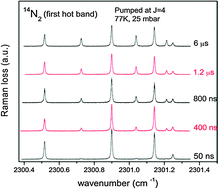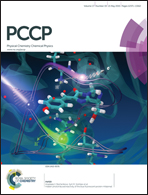Experimental determination of the rate of V–V collisional relaxation in 14N2 in its ground (X1Σg+) electronic state between 77 and 300 K
Abstract
We propose new values for the V–V collisional energy transfer rate constant of 14N2 (X1Σg+) at different temperatures in collisions between molecules in the v = 1 and v = 0 vibrational states. The values were obtained experimentally by means of a time-resolved double resonance pump–probe stimulated Raman setup in which the stimulated Raman technique was used for both the pump and the probe stage. The main feature of the experiment is the fact that population pumping is done with rotational (and thus spin) selectivity, that is, only molecules belonging to the ortho spin variety of 14N2 are promoted to v = 1. The probe stage is then used to monitor the decay of this ortho rotational population placed in v = 1 and the emergence of a para population in that same vibrational level. Since the only possible mechanism for the arrival of para population to v = 1 is collisional V–V energy transfer, the evolution of the ortho/para ratio in v = 1 is used to quantify the rate constant of the process. The measurements were conducted at 77, 136, 226 and 300 K. The 300 K value had been measured and calculated before by other authors, but a spread larger than an order of magnitude existed between their results. Our proposed value is more precise than previous ones and lies near the mid-point of that interval. The low-temperature values of the rate constant are reported here for the first time. The availability of data at several temperatures has allowed us to unequivocally determine the existence of a strong negative temperature dependence of the rate constant between 77 and 300 K that exhibits a linear behavior in a Landau–Teller plot in this temperature interval.


 Please wait while we load your content...
Please wait while we load your content...